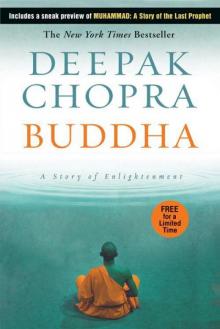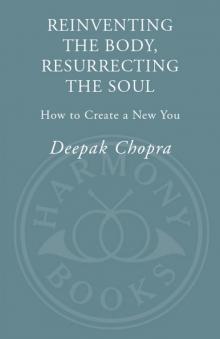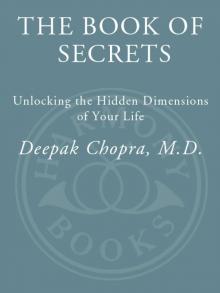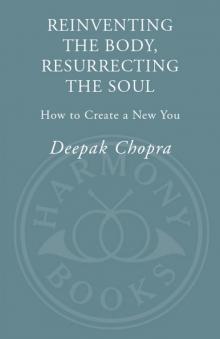- Home
- Deepak Chopra
Reinventing the Body, Resurrecting the Soul Page 9
Reinventing the Body, Resurrecting the Soul Read online
Page 9
How you think.
How you feel.
How you act.
What you believe.
What you expect.
The threats you fear.
The objects of your desires.
The lifestyle decisions you make.
The relationships you focus on.
Your immediate environment.
Your habits and preferences.
At the most basic level, lifestyle choices have genetic consequences. In the wellness movement, approaches such as vegetarian diets, Hatha Yoga, meditation, and psychosocial support have long been seen as good preventive measures. Now it seems that adopting these approaches may stop or even reverse serious illness—heart disease, diabetes, high blood pressure, prostate cancer, obesity, high cholesterol, and other chronic conditions show promising signs in this area. Only recently has research gone to the genetic level of explaining these beneficial changes. Hundreds of genes, it has been found, may be changing their expression in as little as a few months after patients change their lifestyle in a positive direction. Genes associated with cancer, heart disease, and inflammation were down-regulated or “turned off,” whereas protective genes were up-regulated or “turned on.”
At this moment you are making all kinds of choices that weave together the quirky, unpredictable, and creative patterns of your life. Do your genes care? As it happens, they do, very much. It’s been shown that death rates rise significantly after Christmas, for example, and the same spike occurs after mortally ill people have a birthday. The implication is that when someone is dying, she can postpone her time of death until after a day she wants to live to see. (I know of a man slowly dying from brain cancer who passed away when a Lakota Sioux medicine man was brought into his sickroom and performed a ceremony to release the spirit from the body so that it could reach the afterlife.)
It’s as if having a desire is enough to tell your body what to do. Is that enough with genes as well? Influencing a gene used to be considered impossible, but the situation is rapidly changing. Genetic researchers working with mice found that baby mice that were well mothered turned into healthier specimens than baby mice who were badly mothered. A mouse who’s a good mother licks and cleans her offspring almost all the time and stays physically close to them. A bad mouse mother is erratic about grooming her offspring, and wanders away from them. As a result, her offspring grow up to be more susceptible to stress. They are more easily frightened and also show less curiosity about the world, and less willingness to explore it.
In itself, this finding wasn’t dramatic. It had been shown long ago that baby monkeys who were not allowed to cling to their mothers and be nurtured by them grew up emotionally disturbed (you may remember the poignant photos of forlorn infant rhesus monkeys clinging to a wire-mesh imitation of a mother monkey). The radical part of the mouse experiment came when it was discovered that mice who experienced bad mothering turned into bad mothers themselves. They neglected to groom their own offspring enough, and tended to wander away. In other words, the baby mice of bad mothers didn’t acquire new genes, yet they did acquire a new behavior. Suddenly that first early human who decided to stand upright to view the far horizon may not be tied to genes. He may have passed on his new behavior to his children without waiting millennia for a new mutation. But how?
The answer lies at an obscure cellular level known as epigenes. Every strand of DNA is wrapped in a buffer of complex proteins—the epigene—that somehow trigger a gene to turn on or off. When the epigene is affected by something you do or feel, it won’t create new DNA—your genetic inheritance remains the same as at birth. But its behavior can change drastically. So, when a bad mouse mother warps the normal development of her baby, what matters is that the baby’s DNA is activated to start behaving badly, eventually passing on the same bad behavior to future generations. I’ve given a negative example, yet many positive implications open up if we can learn to switch genes on and off. Gene therapy has been a failure in treating cancer, for example, but epigenes may come to the rescue. Because gene therapy tries to replace or change the genes you were born with, the body rebels, producing many undesirable side effects. On the other hand, if the epigene can tell your DNA to prevent a tumor from growing, or to stop the tumor after it starts, then cancer could be defeated simply by asking a cell to behave differently.
If switching a gene on and off is the most natural way to create change, how do we gain control over the switch? Lifestyle changes are a start, but perhaps we possess more direct control, only the switch is hidden. To stay with cancer, there are thousands of documented cases in which an advanced malignancy has disappeared without treatment. These spontaneous remissions, as they are known, have created a vast mythology. All it takes is a rumor that some herb, fruit concoction, gem or color therapy, religious ritual, prayer, or miraculous intervention has saved a life, and dying cancer patients will desperately pursue that avenue. Nobel Prize winner Linus Pauling was convinced that megadoses of vitamin C had cured a small group of terminally ill cancer patients. Complete blood transfusions and so-called blood purification are offered illicitly in Mexico. Because they are labeled as alternative treatments, a vast array of therapies exist whose actions remain completely unknown and unproven.
What we do know is that in rare cases an x factor can cause tumors to retreat for no known reason. It can even happen without any treatment at all: a certainty simply dawns on some patients that they will recover, and their certainty is borne out. That is more in line with traditional faith healing, which attributes cures to an invisible higher power and nothing physical at all. What may unite these wildly disparate approaches (after weeding out the frauds and false rumors) is the power of awareness to switch on a tumor-suppressing gene.
We find ourselves caught in a dilemma. Hope that brings results can’t be called false. On the other hand, reducing all alternative therapies to hope-mongering would be unfair. There may be an unpredictable combination of substance and spirit at work, where a patient’s subjective hope and belief enables a therapy to work. The challenge is very basic: How do you effectively take control of your genes?
Tuning in, tuning out
All of us cause changes to our genes, but it’s a special skill to do so consciously. We aren’t tuned in to the level of our bodies that actively switches genes on and off. It turns out, however, that this level of awareness is available. You can’t go there to target one gene directly, but there’s no need to. You only need to tune in. Tuning your body out is the single greatest harm you can do. Without a clear channel of communication, you can’t expect your cells to respond to your desires and intentions. “Tuning out” is shorthand for withdrawing your attention, judging against your body, and ignoring its signals. As with everything else, there are different degrees of tuning out. Depending on how disconnected you become, your body will send back increasingly severe reactions: absence of pleasure, reduced vitality, discomfort, numbness, and pain.
Progressing from one stage to another can take years, but a sudden trauma like a car accident or serious illness can decrease body awareness quickly and dramatically. When someone near to us dies and we go into grief, for example, the whole spectrum is there: food no longer tastes good (absence of pleasure); we feel listless and tired (reduced vitality); the body feels heavy and sleep doesn’t come easily (discomfort); sensations like heat and cold aren’t felt, and familiar surroundings seem alien and strange (numbness); random aches in the body come and go (pain). There are always mental consequences as well, and quite often people who feel depressed, numb, and empty inside don’t realize that they are seriously disconnected from their bodies.
Here’s a list of what it typically feels like to tune out. Read the list over and ask yourself how many items apply to you personally.
You feel detached from your body and what it’s saying.
You find it hard to feel physical pleasure.
You compare your body unfavorably to that of other people, or to some id
eal of the “perfect” body.
You feel ugly or unworthy in the body you have.
It makes you unhappy to imagine your body shape.
Being touched makes you uncomfortable.
You tend to misinterpret other people’s physical approach as aggressive or, at the very least, startling.
Bonding through physical intimacy isn’t an option.
You feel clumsy and uncoordinated.
The only time you liked your body was when you were young.
You physically don’t consider yourself feminine enough, or masculine enough.
Your body sometimes doesn’t seem to belong to you.
These negative attitudes range from mild to severe. Yet your body always senses when it is being ignored or judged unfavorably. For most people, ignoring their bodies has become a habit. Exposing their bodies to undue stress scarcely brings a second thought. After all, don’t we assume that modern life has turned stressful, beyond our individual control? If you were really tuned in to your body, you’d feel its discomforts before they demanded your attention. Tuning in comes down to becoming more aware. The more aware you are, the more sensitive you are to your body, and vice versa.
Seen symbolically, all disorders are cases where the body becomes a stranger, an enemy, a failed ally, or a defeated victim. To prevent those metaphors from turning into reality, you need to offer reassurance to your body that you will care for it, that you will listen when it speaks.
In Your Life: Tuning In
Once you tune in, your body has an amazing capacity to correct itself. To begin this process, you need to feel comfortable in your body. There has to be a basic connection that isn’t blocked by guilt, shame, and discomfort. If you take the following quiz, it will show you where the work of reconnecting starts for you personally.
Are You at Home in Your Body?
The list below covers the most common things that people feel uncomfortable with when it comes to their bodies. Mark your comfort level with each item, as follows:
E - Enjoyable
D - Don’t mind
U - Uncomfortable
T - Totally avoid
__wearing a revealing bathing suit
__wearing clothes that fit
__looking in a full-length mirror
__trying on clothes in a store
__dancing
__playing team sports
__hugging
__snuggling
__sex with the lights on
__being looked at in public
__describing how you look physically
__being physically flirtatious
__thinking about your weight
__being casually touched by a friend or acquaintance
__hearing others refer to you physically
__sitting quietly, particularly in public
__attempting physical challenges (hiking, running, climbing flights of stairs, etc.)
__being seen nude by your spouse or lover
__undressing at the gym
__having your picture taken
__thinking about being touched physically
__buying a bra or other intimate apparel
This isn’t a quiz where you tally up your scores; it’s a worksheet for getting back in touch with your body. Pick an item that you marked “Uncomfortable,” and write a plan for overcoming it. Your plan begins in awareness. Imagine yourself in the uncomfortable situation. Use a specific image that evokes your discomfort so that you feel it emotionally, and possibly even physically.
Be with that energy. Simply by tuning in to it you are taking the first step toward a new body awareness. Don’t freeze up or get tense. Breathe easily; relax your body. If the image has to do with undressing at the gym, see yourself standing there, but instead of feeling all eyes on you, create a change. Have people look away and pay no attention. Repeat this new scenario several times. See them staring at you, making you embarrassed, then have them turn away. As you repeat the process, your energy around this issue will start to dissipate.
Now proceed to another aspect of the scene, such as stripping down until you are naked. Use the same process as before. See yourself in your discomfort, and then change the scenario. This time make yourself indifferent to being naked. Maybe you are chatting with a friend or rubbing lotion on your leg. Maybe someone walks by without noticing you. Maybe someone comes up to you as you are taking off your clothes and asks for help with something. The point is to add comfort and ease to the troubling situation. Again, repeat the change, like running a movie scene several times.
The ultimate point of this exercise is to get your awareness to shift, allowing a clearer channel of communication with the body. If you are deeply disconnected from your body, this exercise may be too intimidating. If it is, then instead of beginning with an item marked “Uncomfortable,” begin with one marked “Don’t mind.” Eventually, you will be able to get through all the steps of tuning in:
Freeing up stuck energy through visualization.
Stepping into the situation you once felt uncomfortable with.
Feeling indifferent in the situation, to the point that you don’t mind it.
Feeling completely comfortable.
Enjoying and seeking out the once-avoided situation.
You won’t be tuned in until you reach the end of the process. Just keep reminding yourself that every stage of healing takes place in awareness. You won’t do yourself any good by abruptly buying a bikini or letting someone touch you intimately before you are mentally and emotionally comfortable. Keep checking in with the sensations brought up by your body. Be with them; look at them. If you keep returning in small visits to your discomfort zone, your body will begin to respond. Trust it, and don’t push yourself too hard, too fast.
In addition, expose yourself to the comforts of physical sensations that you’ve ignored. Look over the times you marked “Enjoy,” and give your body the nourishment of positive sensations. Remind yourself that your body is the junction between the visible and invisible worlds. The most pleasurable experiences—of love, warmth, beauty, bonding, and nurturing—bridge those worlds. They have a component that your body understands and a component that your mind understands. Let the two merge into one. Then the process of tuning in is complete.
Breakthrough #5
Time Isn’t Your Enemy
When a breakthrough is powerful enough, it can overturn the natural order of things. The whole issue of time fits into this category. Is anything more powerful than time? It rules the cycle of birth and death. It moves forward inexorably. It brings aging and decay. The ultimate liberation for your body would be to overcome the effects of time. In so doing, you would overcome the body’s greatest flaw, which is that it breaks down for no better reason, apparently, than the negative effects of the passage of time.
In this breakthrough you will see that time isn’t your enemy. We can choose to stop giving in to time as if it ruled our lives. There are signs that this is happening already. The present generation invented the “new old age,” which is constantly pushing the biological envelope. In 2005, a Romanian woman named Adriana Illescu became, at age sixty-seven, the oldest mother on record, using in-vitro fertilization to give birth to a healthy baby girl. The event created uneasy feelings around the world, but Illescu’s attitude is typical of rapidly changing beliefs.
“I am only sorry that I don’t look like a young woman for my daughter,” she said. “I am always amazed when I look in the mirror and see myself. There’s such a difference between what I feel and what I see.”
Illescu has shattered the stereotype of motherhood belonging only to the young by asking her body to keep up with how young she felt, and in doing so she was quite consciously pushing the boundaries of aging.
“A little sports, a little activity, and an active intellectual life lead the body to become younger because there are hormones generated in the brain that make you feel better,” she told reporters.
To set a new agenda fo
r the body, attitudes must shift. In the past, old age was feared, and rightly so, because senior citizens were put on the shelf. When attitudes shifted, thanks to better health, longer life spans, and shifting demographics, people began to expect to be vigorous, alert, and useful well beyond the age of sixty-five. A recent poll revealed that more than half of Americans consider seventy to be late middle age and that old age itself didn’t begin until after eighty. The oldest man to finish the London marathon is now 101, continuing to show us what is possible for anyone.
And yet slowing down the aging process isn’t the same as solving the problem of time. Why do we accept the ravages of time at all? Can the body’s worst enemy turn into an ally?
Evolution or erosion?
The problem of time comes down to one thing: your body evolves and erodes simultaneously. Both are constant, invisible forces. The surest way to escape time’s clutches is to keep evolving, and the good news is that sometimes evolution gains the upper hand. Then we feel expansive, optimistic, forward-looking, and eager to discover new things. In that mode, we have all the time in the world. We can forget time and live as if it didn’t exist (as lovers do, or people totally absorbed in work or play). At other times entropy becomes dominant. Now we don’t have time to get important things done, and what time there is wears us down. Bored or depressed, we find our lives losing momentum. As our bodies balance evolution and entropy, the two faces of time silently battle for supremacy. The “new old age” proves that erosion can be resisted through beliefs and attitudes. There is no need to buy into any belief that promotes entropy. Far better to assume, as we have all along, that awareness can change any energy pattern at will.

 Muhammad: A Story of the Last Prophet
Muhammad: A Story of the Last Prophet Buddha
Buddha Power, Freedom, and Grace
Power, Freedom, and Grace Reinventing the Body, Resurrecting the Soul: How to Create a New You
Reinventing the Body, Resurrecting the Soul: How to Create a New You The Book of Secrets: Unlocking the Hidden Dimensions of Your Life
The Book of Secrets: Unlocking the Hidden Dimensions of Your Life Muhammad
Muhammad Reinventing the Body, Resurrecting the Soul
Reinventing the Body, Resurrecting the Soul